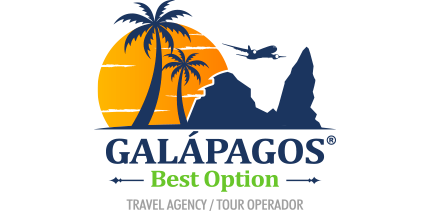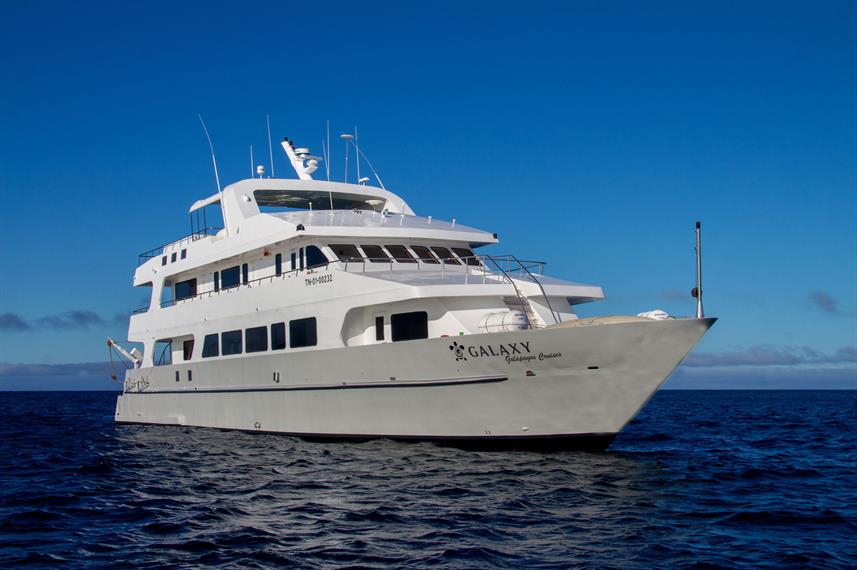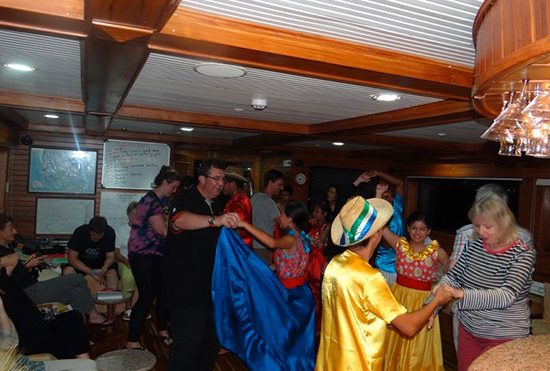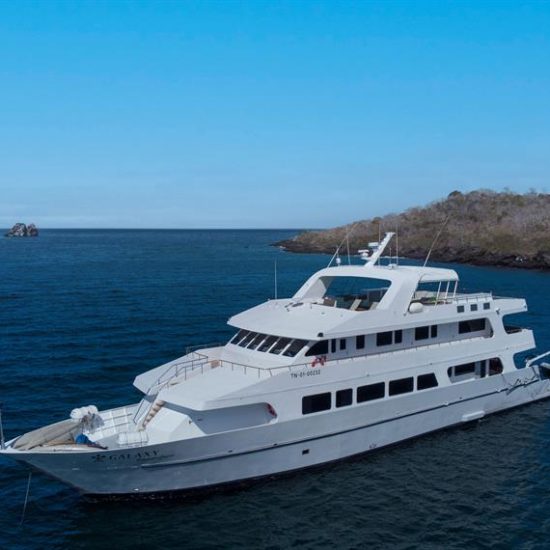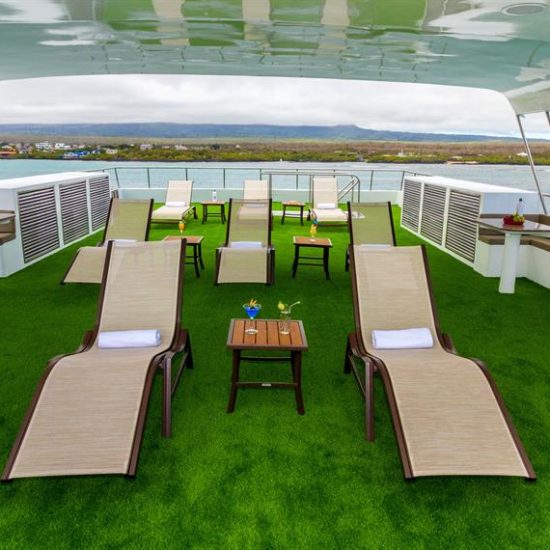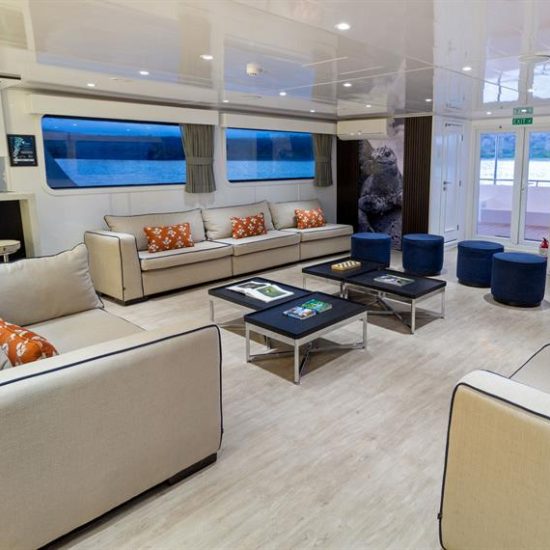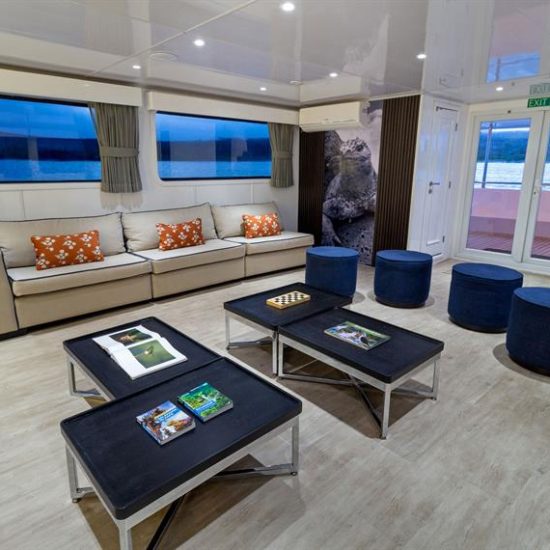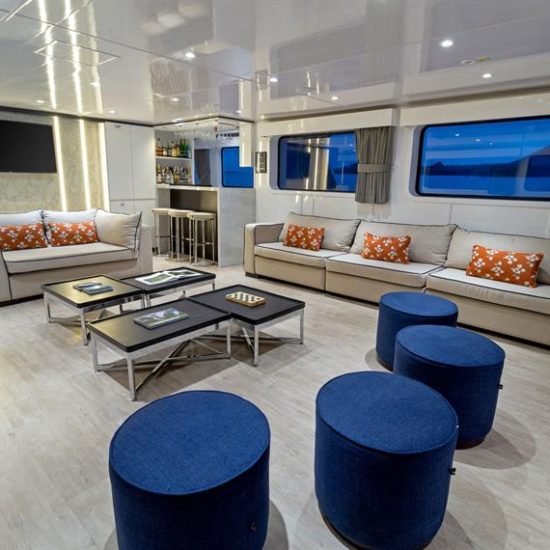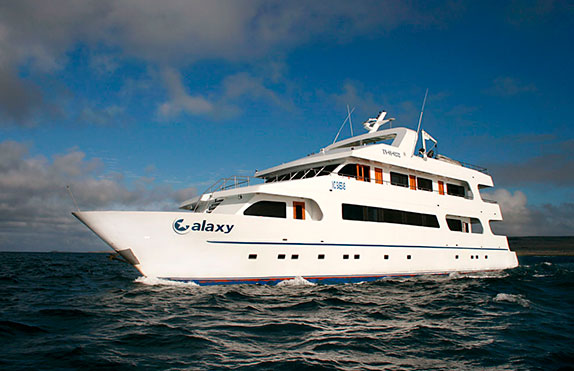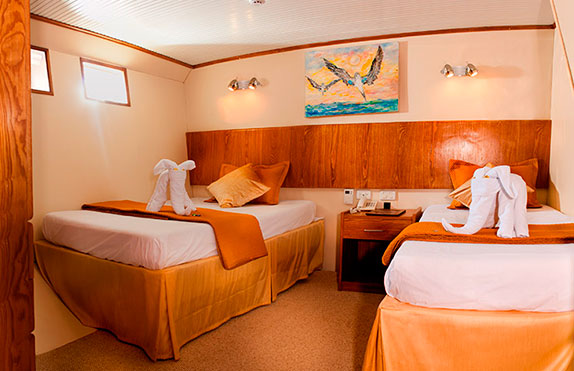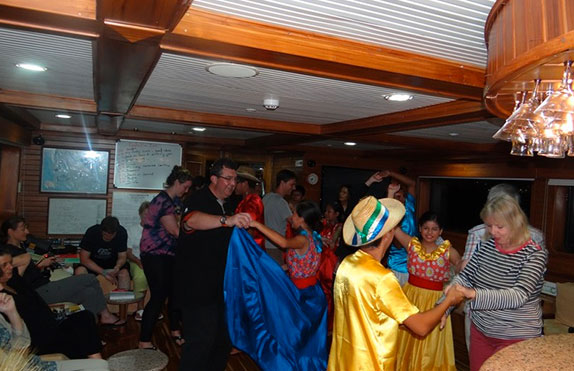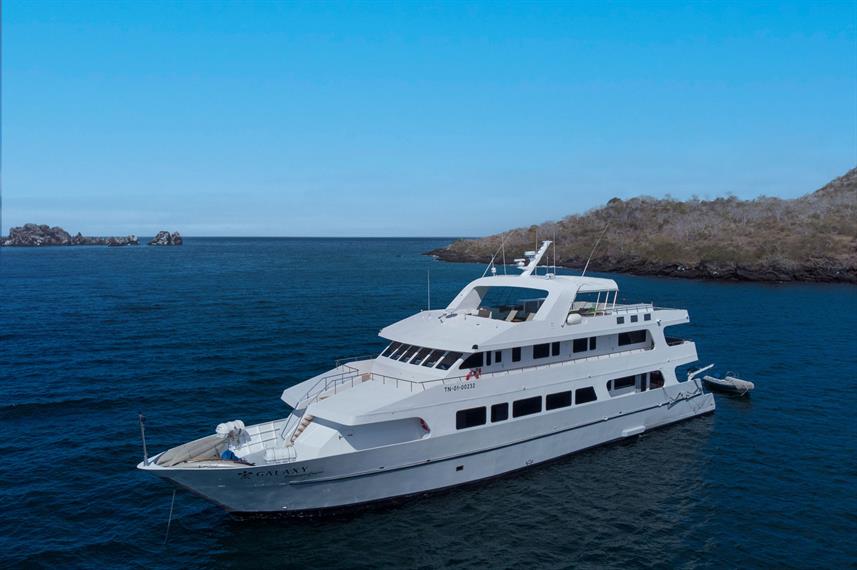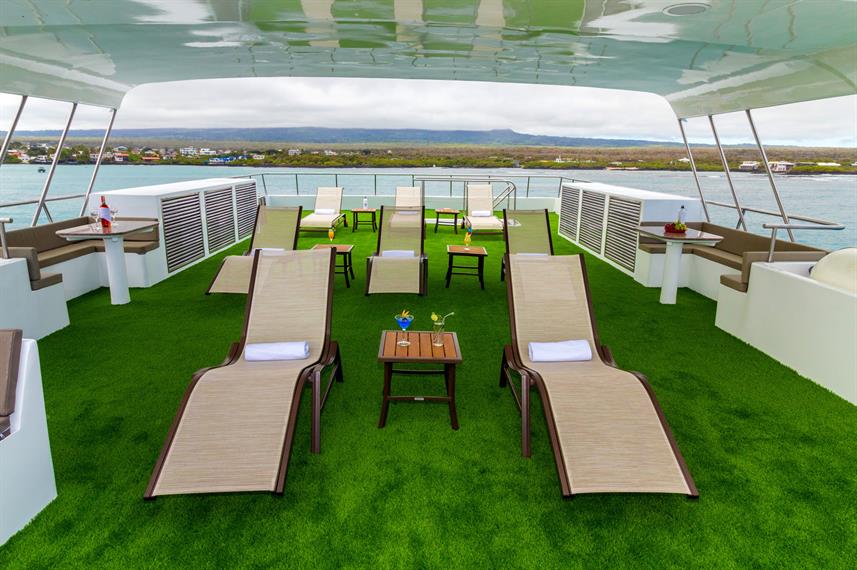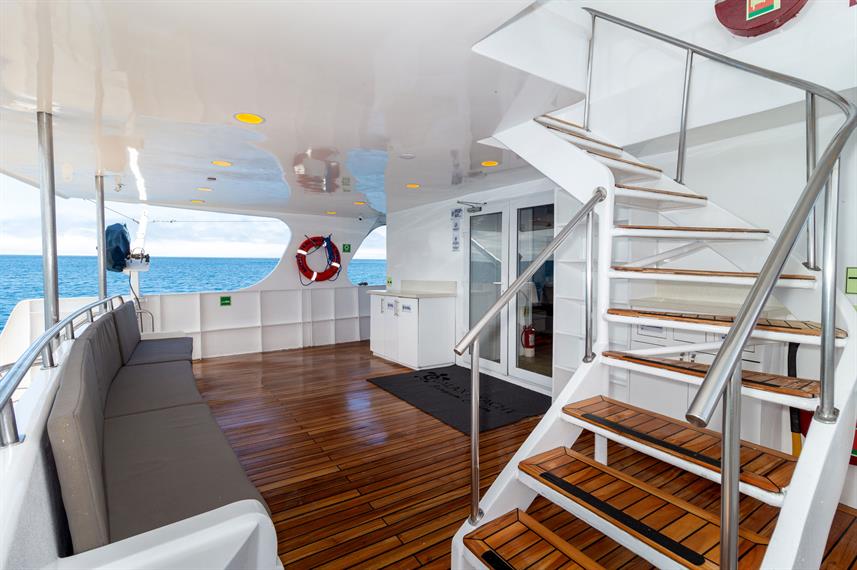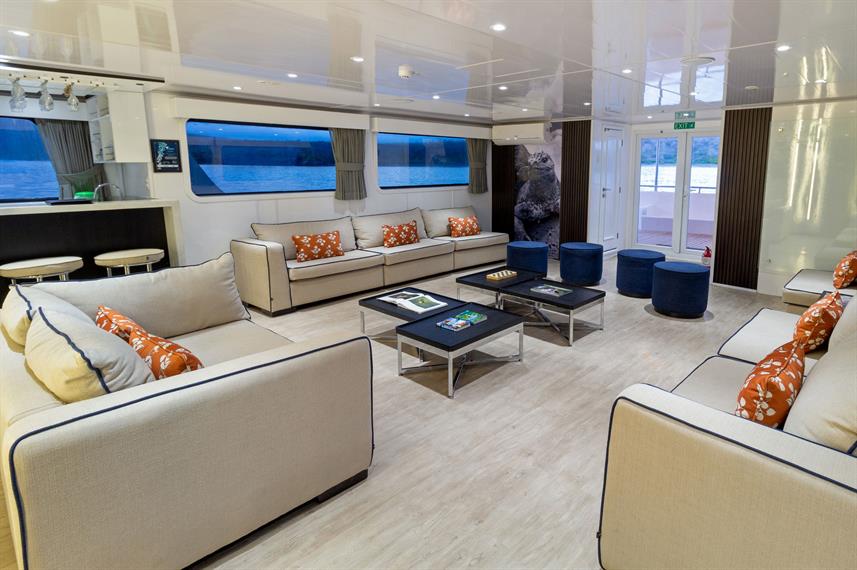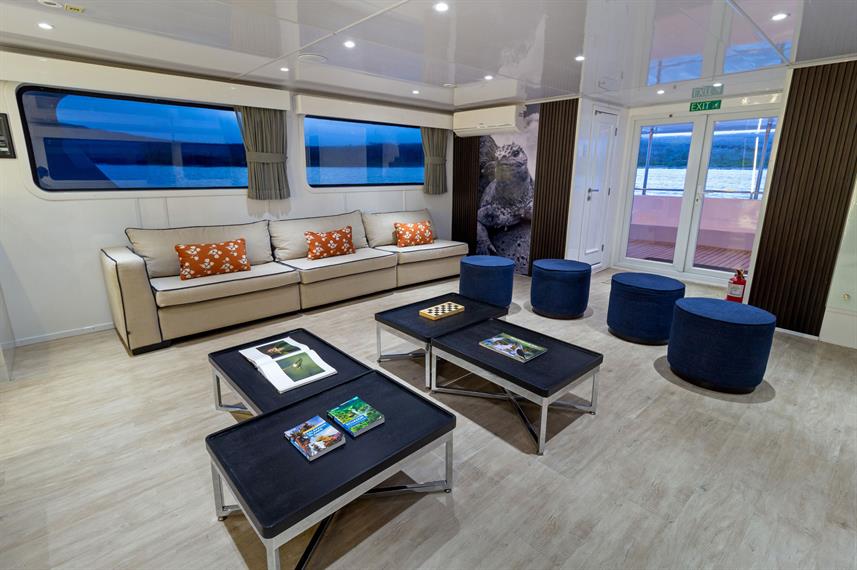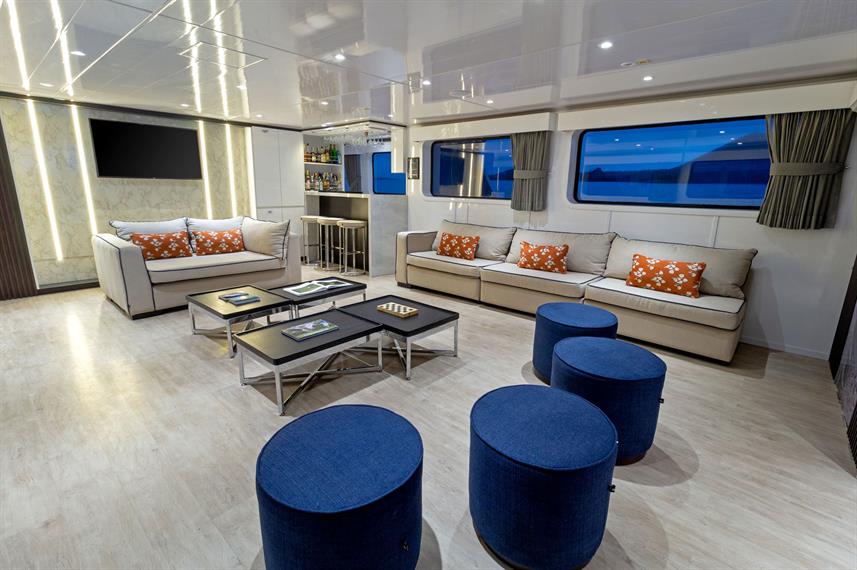The Galaxy liveaboard is a first class yacht offering exciting cruises to the Galapagos Islands. She has the coveted ‘Smart Voyager’ certification, ensuring a commitment to reduce any negative impacts on the sensitive Galapagos environment. The crew and naturalist guides are trained to the highest standard, to offer a personalized service and unforgettable experience. Social areas include a spacious sun deck with loungers which is the perfect place to enjoy the stunning landscapes, outdoor dining room, as well as the indoor lounge, bar, library and dining room. An assortment of table games, videos and books are available for your enjoyment, and a variety of sodas, cocktails, and liquors are available for an extra cost at the bar.
Galaxy Yacht
RESERVE THIS CRUISE
Starting Price Per Person: $3.999,00 USD, all taxes are included.
Please confirm availability for your desired itinerary by contacting us at:
info@galapagosbestoption.com / sales@galapagosbestoption.com / Whatsapp +593 967742545
PAYMENT POLICY
To book and confirm any tour, we must receive 100% of the total amount prior to the tour as follows:
50% due at the time of booking
50% due two weeks before the date of your tour
CANCELLATIONS
Any last minute cancellations or changes by the customer may incur a fee to be imposed by Galapagos Best Option SA.
If for any reason a passenger is not present at the time of their flight they will be considered a no show and will not be subject to any refund by the agency.
Please read our full Cancellation and Refund Policy.
The Galapagos National Park has the right to make any changes to the itinerary due to natural disasters or scientific research projects.
ITINERARY A
Day 1 SATURDAY: BALTRA ISLAND – SANTA CRUZ: HIGHLANDS
Arrive on Baltra Island. This island is known to be inhabited by militaries only. On this island is located one of our mains Galapagos airports. Once you arrive your guide will be waiting for you. Transfer to Santa Cruz Island, we cross the Itabaca Chanel (from airport to this place is around 15 minutes), after this, we take our private bus to Puerto Ayora. Once we arrive in Puerto Ayora, we will go direct to Galaxy Yacht: cabin accommodation and take lunch. After lunch, our first visit is HIGHLANDS OF SANTA CRUZ,where we will trek and will find the giant tortoises in their natural habitat. For this visit, we recommend using sport shoes, long pants, a raincoat, hut, and sunblock. Back to Puerto Ayora. At the night we have a welcome cocktail and the formal presentation of our crew by Capitan. Briefing for the next day.
Day 2 SUNDAY: ISABELA ISLAND
TINTORERAS: Located in the bay of Puerto Villamil, this small island surrounded by calm turquoise waters has an easy trail with great landscapes and very interesting fauna. Along the trail, we will see large numbers of Marine Iguanas basking in the sun, lava lizards, herons, gulls, and sea lions. In the coves, it is easy to find Sea Turtles, rays, and even Penguins. Among the many cracks and channels in the coast sometimes we can see White-tipped Reef Sharks (in Spanish “Tintoreras”). After the visit, we will return to the boat to have breakfast and begin the navigation to the next point.
PM MORENO POINT. After lunch, we will disembark in Moreno Point which is located near Elizabeth Bay on the west coast of Isabela Island. The plethora of birds seen during a dinghy ride along the striking rocky shores or a hike along the path through lava rock leading to tide pools and mangroves create a birdwatcher’s delight. In the tide pools, green sea turtles or white-tip sharks can be spotted.
Day 3 MONDAY: ISABELA ISLAND
ELIZABETH BAYThis is one of the island’s breeding sites for penguins. Located on the west coast of Isabela, Elizabeth Point is a marine visitor site. Visit red mangrove cove: Brown pelicans, flightless cormorants, spotted eagle rays, golden rays, and sea lions are often seen. Lunch E35K08
URBINA BAY:This place is located at the base of Alcedo Volcano between Elizabeth Bay and Tagus Cove. Wet landing. The trail length is around 3.20 Km; during this walk, we can observe land iguanas, hawks, tortoises; also it is possible to see red and blue lobsters.
Day 4 TUESDAY: ISABELA ISLAND & FERNANDINA
ISABELA ISLAND: TAGUS COVE: It is located at west of Darwin Volcano in Isabela Island. During our walk, we will find several inscriptions (names of boat’s pirates) since 1800. Tagus Cove's name has its origin of an England ship that crossed the island looking for Galapagos tortoise to feed the crew. From this area, we can admire Darwin Lake which has saltwater and its deep is 9metes approximately, there are no fish. It is very easy to see different species of birds. Lunch
FERNANDINA ISLAND – ESPINOZA POINT: Fernandina is the 3rd island bigger of Galapagos and has just one visit place: Espinoza Point.
Espinoza Point is a famous site because you will find big colonies of marine iguanas and it is a unique place where the flightless Cormorant lives, Galapagos penguin, hawk, snakes of Galapagos, and many others. From Espinoza Point, we can admire Fernandina Island and its volcano which last eruption was on May 2005.
Fernandina is the only island that doesn’t have any mammals introduced and the open areas are very fragile. During the nesting time of marine iguanas (January to June) we must take care when we are walking. Return to Galaxy.
Day 5 WEDNESDAY: SANTIAGO ISLAND
SANTIAGO ISLAND: EGAS PORT: At this site, we find a black sand beach; at the south of this beach there is a volcano called Pan de Azucar, it has volcanic deposits which have contributed to the formation of this black sand beach.
The crater of this volcano has a salt lake which in warm time becomes dry and it is possible to appreciate a salt mine. Between 1928 and 1930 there were some explorations to this mine but they didn’t function; additionally, it caused damages to the environment because workers used endemic woods. It is not allowed to go down to salt mine.
Lunch on Boat
SANTIAGO ISLAND: ESPUMILLA BEACH & CALETA BUCANERO: One of the main attractions of this site is a Palo Santo wood, the beach, and landscape; the beach is a very important site for tortoises because they use this place for nesting.
Once time, the pigs were the main predatory of tortoise’s eggs; pigs were eradicated with the creation of Isabela Project.
DAY 6 THURSDAY: DAPHNE MAYOR OR DRAGON HILL – SANTA CRUZ ISLAND: BLACK TURTLE COVE
DAPHNE MAYOR: is a volcanic tuff cone, formed by successive explosions produced by the mixture of lava and water. The Galaxy will navigate around the Island.
OR DRAGON HILL: The visitor’s site at Dragon Hill is located in northwestern Santa Cruz Island, and consists of a trail that runs through three different environments at just 1,600 m long.
It gets its name because in 1975, was one of the only places in Santa Cruz Island where there were land iguanas (Conolophus subcristatus) in a healthy state. That same year, the Galapagos National Park and the Charles Darwin Foundation initiated a program to conserve land iguanas. In the lagoons at this site, there is shrimp (Artemia salina), the same as is the food of flamingos; at certain times of the year they are more abundant and therefore the population of these birds is larger.
BLACK TURTLE COVE: Welcome on board. After lunch, our first visit is to Black Turtle Cove which is situated in the northern of Santa Cruz. This bay is surrounded by mangroves and is accessible by dinghy only. The superficial cove is a safe refuge for marine life. Black-tip reef sharks, marine turtles, and a variety of rays are often spotted here.
Day 7 FRIDAY: RABIDA ISLAND – CHINESE HAT
RABIDA ISLAND: The visitor site is located on the east coast of Rabida Island, consisting of a red sand beach, a coastal lagoon behind the beach, and a loop trail. The approximate distance of the trail is 1.1 kilometers.
The color of the rocks and sand on the beach is due to the very porous volcanic material, which with the help of environmental factors (rain, saltwater, and sea breeze, has acted as an oxidizing agent. The main attraction of the place is the red sand beach, scenery, aside from the vegetation of the arid zone and the presence of native and endemic species.
CHINESE HAT: A small islet located near the south-east coast of Santiago. It’s shaped like a Chinese hat when seen from afar. It is an island consisting of a cone type “Splatter” (lava ejected as drops and falls close to where it came from, which forms a cone inclined) that forms the summit and many lava tubes that go down to the coast.
On the west you can see pillow-type lava formations, which are an indicator that the flows were formed under the sea and have been raised upward, which is why coral heads are found on the lava. This visit provides an excellent opportunity for the interpretation of geological features such as lava tubes and lava flows.
The trail is 700 m (round trip) and the minimum time it takes this trek is half an hour.
Day 8 SATURDAY: NORTH SEYMOUR ISLAND – MOSQUERA ISLET
NORTH SEYMOUR: This Island was formed by the lifting of volcanic marine lava. Marine fossils were found on this island; the fossil dates from Pleistocene.
In 1932 the Capitan Alan Hancock and his crew took 72 land iguanas from Baltra Island and the iguanas were introduced in North Seymour Island; the reason for this change was that the iguanas could live in better conditions than in Baltra. The crew of Capitan Hancock found malnourished iguanas in Baltra; in 1934 colonizing people verified that the iguanas were in good conditions. Transfer to the airport.
Enjoy your Galapagos holidays on board our First class cruise: Galaxy Yacht (smart Voyager Certification). On board this well-designed vessel, you can enjoy complete days of explorations and adventure in an oasis of peace and tranquility. Discover the Galapagos Islands in our special itineraries for 4, 5 or 8 until 15 days!
Itinerary is subject to change
PRICE : 3.999,00 USD P.P.
ITINERARY B
DAY 1 SATURDAY: BALTRA ISLAND– MOSQUERA ISLET
Arrive at Baltra Island and Transfer In
MOSQUERA ISLET: This islet is located between Baltra Island and North Seymour. Here, we find the biggest sea lions colony; also it is possible to observe several species of birds. Enjoy its white sand beach. Hiking.
SUNDAY: SANTIAGO ISLAND: SULLIVAN BAY & BARTOLOME ISLAND
SANTIAGO ISLAND: SULLIVAN BAY: wet landing and hiking. Description of the place: all the road and the island is composed of lava flows that have not eroded and cover an extensive area, lava pahoehoe or of cords, Hornitos, mollugo, this plant grows in the lava. Lava Colonizers. Snacks and refreshing beverages expect for you.
BARTOLOME ISLAND: Dry landing, landing wet for the beach, activities to carry out in this island: walk, swimming, snorkeling, and photography. We will walk for a path to the top (114 m) pioneering plants that will observe in this place TIQUILIA, CHAMAESYCE, SCALESIA, the island is formed by cones, pipes of lava by where lava flow. Wet landing, a path to the south beach through mangrove swamps and vegetation of dunes. North beach: Swimming and snorkeling will be the activities that are going to carry out. Since the top of the island Bartolome we will be able to observe the islands as Santiago, Rabida, Isabela. We can find penguins in the Rock Pinnacle.
DAY 2 MONDAY: GENOVESA ISLAND: BARRANCO & DARWIN BAY
BARRANCO: dry landing, activities: hiking.
Also known as Prince Felipe’s stairs. Here, we will walk on the Barranco path. In our journey, we will observe tropical birds, petrels, common frigate, red-foot boobies, mask boobies, dove, and finches. Return to Galaxy. Lunch
DARWIN BAY: wet landing, coral beach, activities for this day: short walks, photography, swimming, snorkeling. The Genovesa is a small island situated to the north of Galapagos our unloading in Darwin bay will be wet. Near the beach, we will find a small forest of mangrove swamps where we will discover a colony of Frigates, marine iguanas, red-foot boobies, and masked boobies, the great terrestrial finch, seagull, herons, finch of cactus. After this visit on the land, we have the option that our passengers enjoy swimming in the bay. Snacks and refreshing beverages expecting for you.
DAY 3 TUESDAY: SAN CRISTOBAL ISLAND: INTERPRETATION CENTER – TRANSFER OUT
INTERPRETATION CENTER: Dry landing. This center is a location in the Main Port. After our breakfast, we will go to our first visit: Interpretation Center of San Cristobal. The most modern and sophisticated architectural space destined for the natural interpretation of Galapagos, where you can know from the volcanic formation of the islands, the evolution of the species, passing for the history of the human settlements to come to understand to its complex systems and model of management.
PM LOBOS ISLAND. Panga Ride, swimming and snorkeling. Description of the place: this place is the habitat of seals, frigates, finches, marine iguanas, lava lizards, and the small endemic Galapagos snake. Here, we can swim and snorkel in the same place. Leon Dormido: This is formed by two rocks of approximately 148m above sea level named thus by its similitude with a lion we will pass between both rocks but we will not disembark because is not possible to do so.
DAY 4 WEDNESDAY: ESPAÑOLA ISLAND
Breakfast early in the morning. Our first visit: BAHIA GARDNER: wet landing, activities for this visit: short walking, swimming, snorkeling, and observation of seals colony.
The sea lion is one of the animals in Galapagos which gets the total attention of the visitors in the Galapagos: they are curious and playful, but at times aggressive; they are nice and loving, but also lazy. In Gardner Bay, we are going to find many of them relaxing on the beach enjoying the sun. Snorkeling in the area where we will be able to swim with them, besides you observe these fascinating animals, we will swim with the sea turtles, diversity of tropical fish, marine iguanas, etc. We will return to the ship, to sail toward the following island. Lunch.
SUAREZ POINT: dry landing, activities that were carried out in this place: walking; recommendable clothes: sports shoes, hat, cap, solar lotion. There is no color more amazing and outstanding in this tropical desert island than the blue-foot boobies; they have an impressive form to “greeting” and it is a real spectacle to see the ritualistic parade of the entourage. On several islands, we can admire the birds nest and feed.
In this place, we will be able to observe the Albatross with a weight from three to four kilograms and an importance of more than two meters, this creature of aristocratic aspect is one of the largest birds of the islands. Around twelve thousand couples have their nests in the Española Island (some few in the Silver Island near to mainland Ecuador). This species is considered endemic from this island during our walking we will be able to observe these fantastic birds, we will be part of the beautiful landscapes that are offered only by this island.
Important Note: Albatross will be not possible to see between January and March. Also, we will observe colonies of marine iguanas, zayapas, mask boobies, finches, Española cucuves, and seagulls unique on the island. Our walking will be for lava rock path where we will be able to admire the hollow blowers. The vegetation of this island is of red mangrove. Delicious Snacks and fresh beverages expect for you.
DAY 5 THURSDAY: FLOREANA ISLAND
Breakfast early in the morning. Our first visit will be POST OFFICE (Mail Bay): Wet landing. Activities in this place: short walk, swimming, snorkeling, review of the mail. Description of the Place: it is situated to the north of Floreana Island. The Post Office Bay name is because Capitan James Colnett installed an empty Ron barrel, to use as the post office for the whaling fleets that frequented the Galapagos Islands. You can send some postcards from here to your friends and relatives or interchange letter to deliver in their destiny. Return. Delicious snacks and beverages will be expected for you and lunch
PUNTA CORMORANT: wet landing, snorkeling, and short trekking. This point is located at the west of Floreana Island and it is famous to have a dark green beach due to the great number of olivine crystals. You can see many marine invertebrates, as well as also sea lions, sea iguanas, frigates, and pelicans. Second visit: DEVIL´S CROWN: Activities in this place: panga ride and optional swimming. Panga ride around a small island, this place was a satellite islet of the island Floreana. Here, we will find a group of rocks that seem to have a crown, due to the constant erosion caused by the sea. It is one of the better places to do snorkeling (superficial diving) in the interior and around the crown, with excellent visibility to admire a great variety of fishes and sea animals.
DAY 6 FRIDAY: SANTA FE ISLAND & SOUTH PLAZAS ISLAND
SANTA FE: Wet landing, activities for this day: hiking, swimming, and snorkeling. Description of this place: With 24 Km2 and 60 meters of height above sea level, it is an almost central island that has a unique place of visit: an incredible bay with turquoise water protected by a natural barrier of rocks and from you can appreciate colonies of seals and hawks flying over. It is home to one of the two species of land iguanas that have the islands, their main food is the leaves and fruits of the large and thick cactus. Crabs, nocturnal herons, marine iguanas, cucuves and land doves are seen frequently. The Bay is an excellent place to swim and snorkel. Marine Tortoises, rays, sea lions, and tropical fishes are an amazing attraction! Snacks and refreshing beverages expect for you on board. Lunch. Navigation toward South Plazas Island.
SOUTH PLAZAS are two small islands, created by land uplift where land iguanas are known to be smaller; they nest during the warm time. The hike goes along an extraordinary cliff where seabirds nest.
Approximately, on this Island, there are 1000 sea lions (Zalophus wollebaeki) and they are located on the south side of Plazas.
DAY 7 SATURDAY: SANTA CRUZ ISLAND
We take our breakfast very early in the morning. Our luggage and all your belongings should be a list to check out on the ship, our last visit: ESTACION CHARLES DARWIN.
Charles Darwin Station is located in the Main Port of Santa Cruz Island, we will take the private bus that takes us to the entrance of the center of breeding where we go to appreciate tortoises and land iguanas in captivity, this center is the main site of breeding of the islands. Animals that were in danger of extinction in the different islands are maintained in captivity and thanks to the dedicated work of several institutions some species are being saved. Here is where the most famous tortoise “the Solitary George” the last survivor of the species of Pinta Island lived. Transfer Out.
PRICE : 3.999,00 USD P.P.
- Airport Transfers
- Naturalist Guide Certified by the Galapagos National Park
- Full Meals
- Coffee, Tea and Snacks
- Snorkel Gear (Mask, Fins and Snorkel)
- Wetsuit
- Private Bathroom With Hot Water
- Air Conditioning
- Entrance Fee to Galapagos National Park $100 USD
- Immigration Control Card $20 USD
- Personal Expenses
- Tips for the Crew and Guide
- Galapagos Flights ($450 to $550 USD – ask us for a quote!)
- Alcoholic Beverages and Soft Drinks
